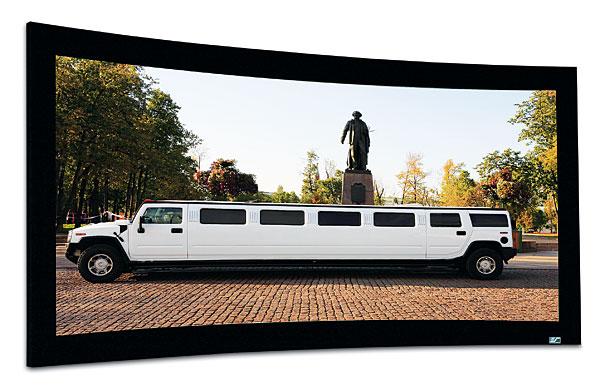How To Choose a Video Projection Screen

When it comes to setting up a great video projection system in your home theater, the screen is nearly as important as the projector. A white wall or sheet simply won’t do, except in a pinch as a temporary stopgap. There’s no substitute for the real thing.
But choosing the right real thing requires research, together with examination of your individual needs. How tightly can you control the room lighting? How big do you want the image to be? What shape screen do you want—that is, what aspect ratio—and do you want a screen that can mask off the unused portions when the source is a different aspect? Can the screen have a fixed frame, or do you want it to be retractable? How much gain should the screen have? Which screen will best match your projector? And last but not least, how will 3D affect all of these other considerations?
I’ll attempt to clear away some of these cobwebs, but if serious questions persist, there are skilled custom installers in most parts of the country who, for a price, can help you select the right screen and install it properly. But even if you hire an expert, you’ll be miles ahead with a little knowledge of your own.
Room Lighting
How much room lighting should you have for the best projection experience? The answer to that was once obvious: A projector can do its best only if the room is as dark as possible. The following always holds: Projectors do not project black; black is simply the absence of light, either from the projector or from any other light source in the room. In the ideal case, with both the room lights and the projector turned off, the room should be so dark that you can’t see your hand in front of your face. In addition, the walls, ceiling, and floor should be as dark as possible. Black or very dark gray are ideal. This reduces the chances for light from the projected image to reflect back on the screen and degrade the picture.

But let’s get real. While a bat cave is the best environment for video projection, not many videophiles can or will go this far. But a subdued environment—neutral grays or beige on the walls, floor, and ceiling, plus lights out when viewing—is worth aiming for. There are also new gray and nearly black screens that can minimize the negative effects of room reflections and room lighting. (Check my review of the Black Diamond II from Screen Innovations on page 42.) If total darkness simply isn’t possible, you can cleverly set up spotlights that won’t throw any light on the screen.
So what about those fancy custom installations you see in these pages and elsewhere that show cheery room lighting and a bright, well-saturated image on the screen? Sorry, the screen images in those shots are almost invariably Photoshopped in. Otherwise you’d see a washed-out picture or a blank screen. The pictures are there to show off the room décor, not to demonstrate that you can have it all with the room lights set to stun. There’s a reason your local multiplex turns off the house lights during the show, and it isn’t just to save money on their electric bills.

Configurations
Your screen choices include fixed-frame screens that either mount on a wall or on an optional stand, retractable screens, and super-wide, CinemaScope-shaped screens—either flat or curved. You may use the latter with an anamorphic lens and special processing to display 2.35:1 films with no black bars. Such a screen will have bars on the sides with standard widescreen (16:9) or older (4:3) movies, but they can often be fitted with adjustable powered masking to blacken them. Various degrees of masking are also available for the more common 16:9 screens when you show 2.35:1 or 4:3 sources. At the low end of the price range, a do-it-yourself screen paint kit from Goo Systems (and other suppliers) can run you under $200. At the high end, you can pay over $20,000 for a 10-foot-wide, 2.35:1 CineCurve screen with powered masking from Stewart Filmscreen.
Screen Size
The dimensions of the wall where you plan to install your screen will limit the screen’s width and height. For the best sound and optimum surround speaker placement, the combination of screen size and room length should be such that you can sit a reasonable distance from the screen and at least a few feet from the wall behind you, if possible. You’ll need more room at the rear if you plan to use more than one row of seats, either permanent or temporary, for occasional guests.
You’ll also want to check your projector’s throw distance to be certain that it can fill the screen at the available room length, including a foot or so to spare for the projector connections—and any calculation errors. This may limit the size screen you can accommodate. For various reasons, it’s often best to locate the projector as far from the screen as its zoom range will allow. You should also confirm whether the projector and screen manufacturer’s specs refer to screen size by width or diagonal; a wrong assumption could result in an unpleasant surprise. If you’re planning on the most common screen shape, 16:9, it’s useful to know that the diagonal measurement times 0.87 equals the screen width.



















































